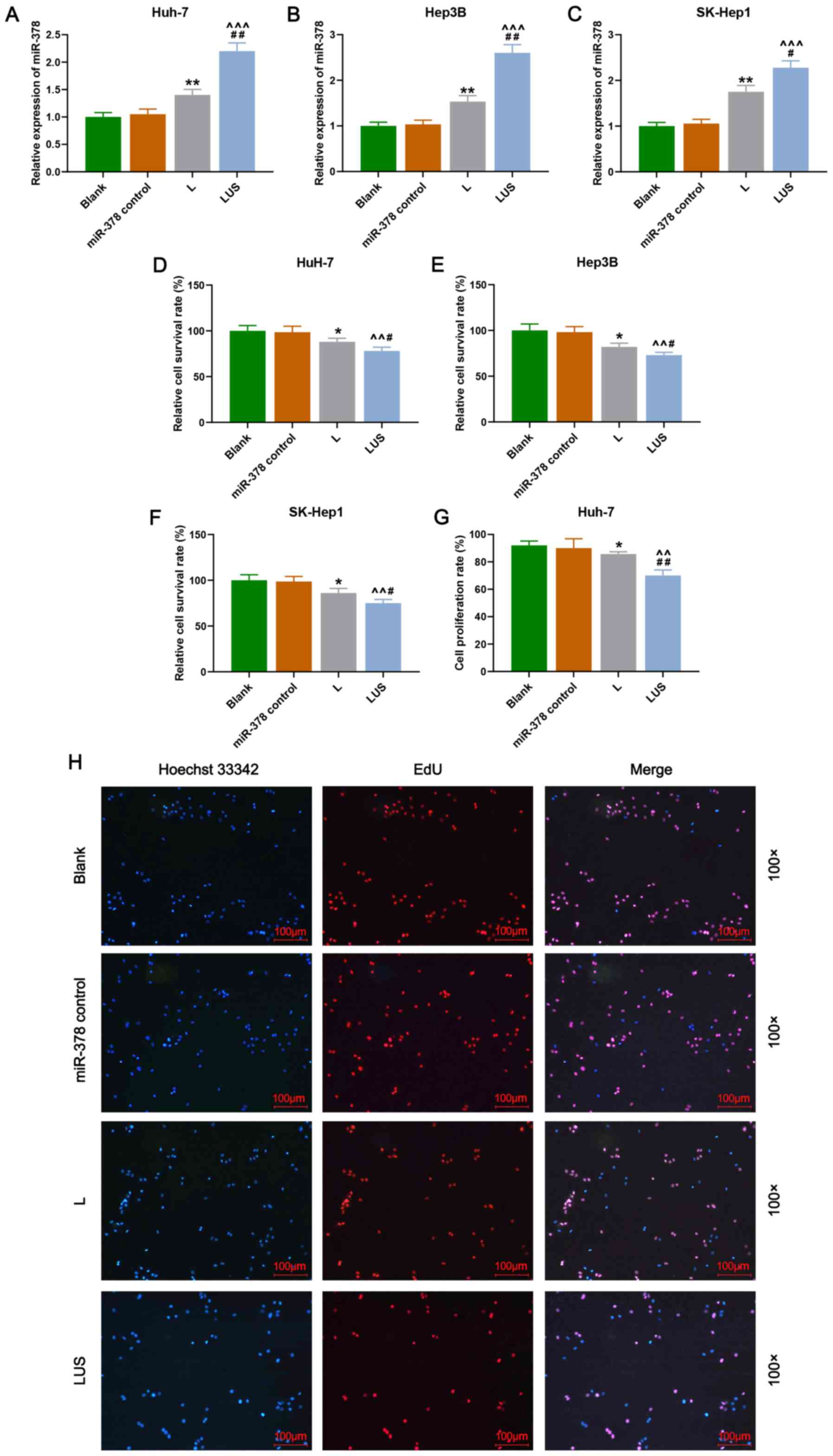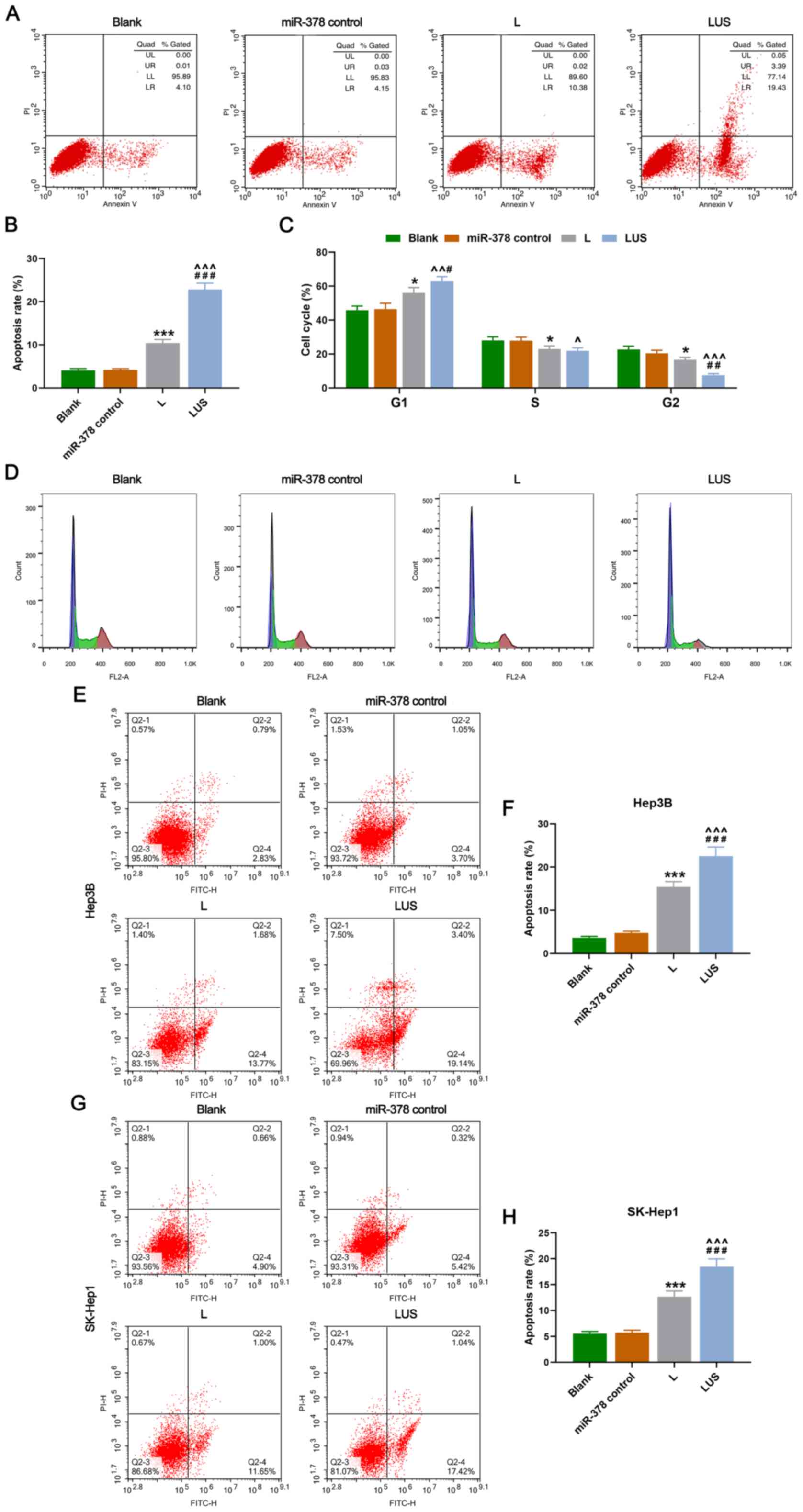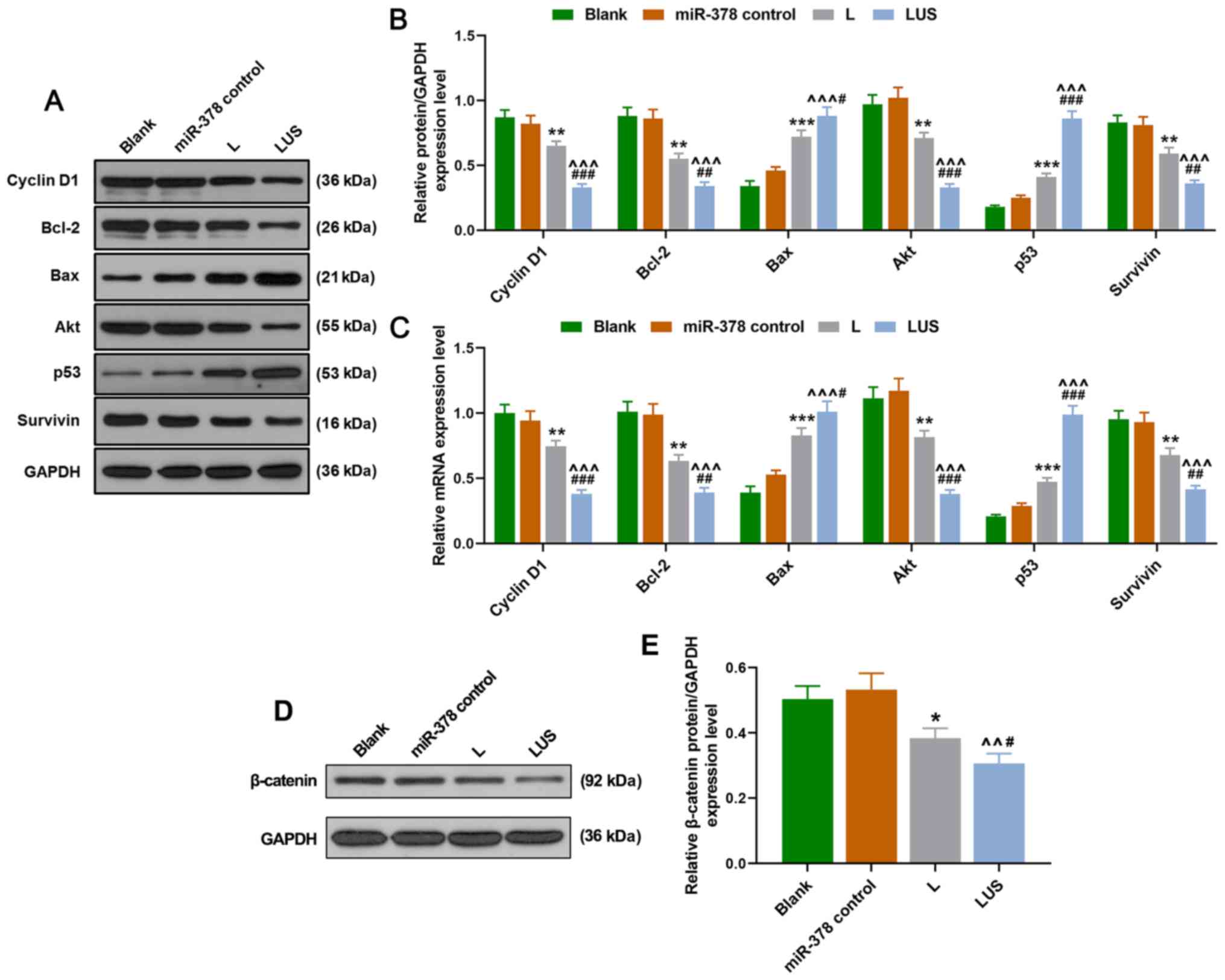|
1
|
Cheng AL, Kang YK, Chen Z, Tsao CJ, Qin S,
Kim JS, Luo R, Feng J, Ye S, Yang TS, et al: Efficacy and safety of
sorafenib in patients in the Asia-Pacific region with advanced
hepatocellular carcinoma: A phase III randomised, double-blind,
placebo-controlled trial. Lancet Oncol. 10:25–34. 2009. View Article : Google Scholar : PubMed/NCBI
|
|
2
|
Llovet JM, Ricci S, Mazzaferro V, Hilgard
P, Gane E, Blanc JF, de Oliveira AC, Santoro A, Raoul JL, Forner A,
et al: Sorafenib in advanced hepatocellular carcinoma. N Engl L
Med. 359:378–390. 2008. View Article : Google Scholar
|
|
3
|
Bruix J and Sherman M; American
Association for the Study of Liver Diseases, : Management of
hepatocellular carcinoma: An update. Hepatology. 53:1020–1022.
2011. View Article : Google Scholar : PubMed/NCBI
|
|
4
|
Llovet JM and Bruix J: Systematic review
of randomized trials for unresectable hepatocellular carcinoma:
Chemoembolization improves survival. Hepatology. 37:429–442. 2003.
View Article : Google Scholar : PubMed/NCBI
|
|
5
|
Nam SW, Park JY, Ramasamy A, Shevade S,
Islam A, Long PM, Park CK, Park SE, Kim SY, Lee SH, et al:
Molecular changes from dysplastic nodule to hepatocellular
carcinoma through gene expression profiling. Hepatology.
42:809–818. 2005. View Article : Google Scholar : PubMed/NCBI
|
|
6
|
Hoshida Y, Villanueva A, Kobayashi M, Peix
J, Chiang DY, Camargo A, Gupta S, Moore J, Wrobel MJ, Lerner J, et
al: Gene expression in fixed tissues and outcome in hepatocellular
carcinoma. N Engl J Med. 359:1995–2004. 2008. View Article : Google Scholar : PubMed/NCBI
|
|
7
|
Van Roosbroeck K and Calin GA: Cancer
hallmarks and MicroRNAs: The therapeutic connection. Adv Cancer
Res. 135:119–149. 2017. View Article : Google Scholar : PubMed/NCBI
|
|
8
|
Wang G, Song L, Hou X, Kala S, Wong KF,
Tang L, Dai Y and Sun L: Surface-modified GVs as nanosized contrast
agents for molecular ultrasound imaging of tumor. Biomaterials.
236:1198032020. View Article : Google Scholar : PubMed/NCBI
|
|
9
|
Qiu L, Leng QY and Luo Y: Progress of
ultrasound microbubble contrast technology in the diagnosis and
treatment of clinical diseases. Sichuan Da Xue Xue Bao Yi Xue Ban.
45:974–978. 2014.(In Chinese). PubMed/NCBI
|
|
10
|
Liu Y, Miyoshi H and Nakamura M:
Encapsulated ultrasound microbubbles: Therapeutic application in
drug/gene delivery. J Control Release. 114:89–99. 2006. View Article : Google Scholar : PubMed/NCBI
|
|
11
|
Price RJ and Kaul S: Contrast ultrasound
targeted drug and gene delivery: An update on a new therapeutic
modality. J Cardiovasc Pharmacol Ther. 7:171–180. 2002. View Article : Google Scholar : PubMed/NCBI
|
|
12
|
Wallace N and Wrenn SP: Ultrasound
triggered drug delivery with liposomal nested microbubbles.
Ultrasonics. 63:31–38. 2015. View Article : Google Scholar : PubMed/NCBI
|
|
13
|
Mountford PA, Sirsi SR and Borden MA:
Condensation phase diagrams for lipid-coated perfluorobutane
microbubbles. Langmuir. 30:6209–6218. 2014. View Article : Google Scholar : PubMed/NCBI
|
|
14
|
Kooiman K, van Rooij T, Qin B, Mastik F,
Vos HJ, Versluis M, Klibanov AL, de Jong N, Villanueva FS and Chen
X: Focal areas of increased lipid concentration on the coating of
microbubbles during short tone-burst ultrasound insonification.
PLoS One. 12:e01807472017. View Article : Google Scholar : PubMed/NCBI
|
|
15
|
Myrset AH, Fjerdingstad HB, Bendiksen R,
Arbo BE, Bjerke RM, Johansen JH, Kulseth MA and Skurtveit R: Design
and characterization of targeted ultrasound microbubbles for
diagnostic use. Ultrasound Med Biol. 37:136–150. 2011. View Article : Google Scholar : PubMed/NCBI
|
|
16
|
Lammertink B, Deckers R, Storm G, Moonen C
and Bos C: Duration of ultrasound-mediated enhanced plasma membrane
permeability. Int J Pharm. 482:92–98. 2015. View Article : Google Scholar : PubMed/NCBI
|
|
17
|
Yang PS, Tung FI, Chen HP, Liu TY and Lin
YY: A novel bubble-forming material for preparing
hydrophobic-agent-loaded bubbles with theranostic functionality.
Acta Biomater. 10:3762–3774. 2014. View Article : Google Scholar : PubMed/NCBI
|
|
18
|
Rychak JJ and Klibanov AL: Nucleic acid
delivery with microbubbles and ultrasound. Adv Drug Deliv Rev.
72:82–93. 2014. View Article : Google Scholar : PubMed/NCBI
|
|
19
|
Ran LW, Wang H, Lan D, Jia HX and Yu SS:
Effect of RNA interference targeting STAT3 gene combined with
ultrasonic irradiation and SonoVue microbubbles on proliferation
and apoptosis in keratinocytes of psoriatic lesions. Chin Med J
(Engl). 131:2097–2104. 2018. View Article : Google Scholar : PubMed/NCBI
|
|
20
|
Livak KJ and Schmittgen TD: Analysis of
relative gene expression data using real-time quantitative PCR and
the 2(-Delta Delta C(T)) method. Methods. 25:402–408. 2001.
View Article : Google Scholar : PubMed/NCBI
|
|
21
|
Wang H, Li X, Li T, Wang L, Wu X, Liu J,
Xu Y and Wei W: Multiple roles of microRNA-146a in immune responses
and hepatocellular carcinoma. Oncol Lett. 18:5033–5042.
2019.PubMed/NCBI
|
|
22
|
Lin X, Xiaoqin H, Jiayu C, Li F, Yue L and
Ximing X: Long non-coding RNA miR143HG predicts good prognosis and
inhibits tumor multiplication and metastasis by suppressing
mitogen-activated protein kinase and Wnt signaling pathways in
hepatocellular carcinoma. Hepatol Res. 49:902–918. 2019. View Article : Google Scholar : PubMed/NCBI
|
|
23
|
Zhong XZ, Deng Y, Chen G and Yang H:
Investigation of the clinical significance and molecular mechanism
of miR-21-5p in hepatocellular carcinoma: A systematic review based
on 24 studies and bioinformatics investigation. Oncol Lett.
17:230–246. 2019.PubMed/NCBI
|
|
24
|
Kim JK and Diehl JA: Nuclear cyclin D1: An
oncogenic driver in human cancer. J Cell Physiol. 220:292–296.
2009. View Article : Google Scholar : PubMed/NCBI
|
|
25
|
Qie S and Diehl JA: Cyclin D1, cancer
progression, and opportunities in cancer treatment. J Mol Med
(Berl). 94:1313–1326. 2016. View Article : Google Scholar : PubMed/NCBI
|
|
26
|
Witzel II, Koh LF and Perkins ND:
Regulation of cyclin D1 gene expression. Biochem Soc Trans.
38:217–222. 2010. View Article : Google Scholar : PubMed/NCBI
|
|
27
|
Hayman L, Chaudhry WR, Revin VV, Zhelev N
and Bourdon JC: What is the potential of p53 isoforms as a
predictive biomarker in the treatment of cancer? Expert Rev Mol
Diagn. 19:149–159. 2019. View Article : Google Scholar : PubMed/NCBI
|
|
28
|
Tiwari B, Jones AE and Abrams JM:
Transposons, p53 and genome security. Trends Genet. 34:846–855.
2018. View Article : Google Scholar : PubMed/NCBI
|
|
29
|
Xue Y, San Luis B and Lane DP: Intratumour
heterogeneity of p53 expression; causes and consequences. J Pathol.
249:274–285. 2019. View Article : Google Scholar : PubMed/NCBI
|
|
30
|
Chabeda A, Yanez RJR, Lamprecht R, Meyers
AE, Rybicki EP and Hitzeroth II: Therapeutic vaccines for high-risk
HPV-associated diseases. Papillomavirus Res. 5:46–58. 2018.
View Article : Google Scholar : PubMed/NCBI
|
|
31
|
O'Neill JW and Hockenbery DM:
Bcl-2-related proteins as drug targets. Curr Med Chem.
10:1553–1562. 2003. View Article : Google Scholar : PubMed/NCBI
|
|
32
|
Brown LM, Hanna DT, Khaw SL and Ekert PG:
Dysregulation of BCL-2 family proteins by leukemia fusion genes. J
Biol Chem. 292:14325–14333. 2017. View Article : Google Scholar : PubMed/NCBI
|
|
33
|
Peña-Blanco A and García-Sáez AJ: Bax, Bak
and beyond-mitochondrial performance in apoptosis. FEBS J.
285:416–431. 2018. View Article : Google Scholar : PubMed/NCBI
|
|
34
|
Renault TT, Dejean LM and Manon S: A
brewing understanding of the regulation of Bax function by Bcl-xL
and Bcl-2. Mech Ageing Dev. 161:201–210. 2017. View Article : Google Scholar : PubMed/NCBI
|
|
35
|
Stefanaki C, Antoniou C, Stefanaki K,
Petrikos G, Argyrakos T, Constantinidou CV, Karentzou O, Stratigos
A and Katsambas A: Bcl-2 and Bax in congenital naevi. Br J
Dermatol. 154:1175–1179. 2006. View Article : Google Scholar : PubMed/NCBI
|
|
36
|
Abu Zeid EH, Hussein MMA and Ali H:
Ascorbic acid protects male rat brain from oral potassium
dichromate-induced oxdative DNA damage and apoptotic changes: The
expression patterns of caspase-3, P 53, Bax, and Bcl-2 genes.
Environ Sci Pollut Res Int. 25:13056–13066. 2018. View Article : Google Scholar : PubMed/NCBI
|
|
37
|
Zhang Y, Yang X, Ge X and Zhang F:
Puerarin attenuates neurological deficits via Bcl-2/Bax/cleaved
caspase-3 and Sirt3/SOD2 apoptotic pathways in subarachnoid
hemorrhage mice. Biomed Pharmacother. 109:726–733. 2019. View Article : Google Scholar : PubMed/NCBI
|
|
38
|
Lien EC, Dibble CC and Toker A: PI3K
signaling in cancer: Beyond AKT. Curr Opin Cell Biol. 45:62–71.
2017. View Article : Google Scholar : PubMed/NCBI
|
|
39
|
Driessen GJ, IJspeert H, Wentink M, Yntema
HG, van Hagen PM, van Strien A, Bucciol G, Cogulu O, Trip M,
Nillesen W, et al: Increased PI3K/Akt activity and deregulated
humoral immune response in human PTEN deficiency. J Allergy Clin
Immunol. 138:1744–1747.e1745. 2016. View Article : Google Scholar : PubMed/NCBI
|
|
40
|
Li Y, Fu LX, Zhu WL, Shi H, Chen LJ and Ye
B: Blockade of CXCR6 reduces invasive potential of gastric cancer
cells through inhibition of AKT signaling. Int J Immunopathol
Pharmacol. 28:194–200. 2015. View Article : Google Scholar : PubMed/NCBI
|
|
41
|
Han G, Gong H, Wang Y, Guo S and Liu K:
AMPK/mTOR-mediated inhibition of survivin partly contributes to
metformin-induced apoptosis in human gastric cancer cell. Cancer
Biol Ther. 16:77–87. 2015. View Article : Google Scholar : PubMed/NCBI
|
|
42
|
Liu JL, Gao W, Kang QM, Zhang XJ and Yang
SG: Prognostic value of survivin in patients with gastric cancer: A
systematic review with meta-analysis. PLoS One. 8:e719302013.
View Article : Google Scholar : PubMed/NCBI
|
|
43
|
An J, Liu J, Liu L, Liu Y, Pan Y, Huang M,
Qi F, Wen J, Xie K, Ma H, et al: A genetic variant in primary
miR-378 is associated with risk and prognosis of hepatocellular
carcinoma in a Chinese population. PLoS One. 9:e937072014.
View Article : Google Scholar : PubMed/NCBI
|
|
44
|
Hyun J, Wang S, Kim J, Rao KM, Park SY,
Chung I, Ha CS, Kim SW, Yun YH and Jung Y: MicroRNA-378 limits
activation of hepatic stellate cells and liver fibrosis by
suppressing Gli3 expression. Nat Commun. 7:109932016. View Article : Google Scholar : PubMed/NCBI
|
|
45
|
Zhou J, Han S, Qian W, Gu Y, Li X and Yang
K: Metformin induces miR-378 to downregulate the CDK1, leading to
suppression of cell proliferation in hepatocellular carcinoma.
OncoTargets Ther. 11:4451–4459. 2018. View Article : Google Scholar
|
|
46
|
Li XH, Zhou P, Wang LH, Tian SM, Qian Y,
Chen LR and Zhang P: The targeted gene (KDRP-CD/TK) therapy of
breast cancer mediated by SonoVue and ultrasound irradiation in
vitro. Ultrasonics. 52:186–191. 2012. View Article : Google Scholar : PubMed/NCBI
|
|
47
|
Thomas CE, Ehrhardt A and Kay MA: Progress
and problems with the use of viral vectors for gene therapy. Nat
Rev Genet. 4:346–358. 2003. View Article : Google Scholar : PubMed/NCBI
|
|
48
|
Ding B, Li T, Zhang J, Zhao L and Zhai G:
Advances in liver-directed gene therapy for hepatocellular
carcinoma by non-viral delivery systems. Curr Gene Ther. 12:92–102.
2012. View Article : Google Scholar : PubMed/NCBI
|
|
49
|
Delalande A, Bastié C, Pigeon L, Manta S,
Lebertre M, Mignet N, Midoux P and Pichon C: Cationic gas-filled
microbubbles for ultrasound-based nucleic acids delivery. Biosci
Rep. 37:BSR201606192017. View Article : Google Scholar : PubMed/NCBI
|
|
50
|
Qin P, Han T, Yu ACH and Xu L: Mechanistic
understanding the bioeffects of ultrasound-driven microbubbles to
enhance macromolecule delivery. J Control Release. 272:169–181.
2018. View Article : Google Scholar : PubMed/NCBI
|

















